Cichlazoma several is a prominent representative of the Tsikhlov family. These fish are quite simple to keep and brightly colored. In the aquariums of lovers of this species, you can find the entire palette of shades: from a sunny orange to enchanting azure. Intertwining with each other, red, yellow, and blue sparkles are woven into intricate patterns – no wonder that cichlazoma several is so popular among aquarists!
General information
Tsichlazoma severum or false discus (Heros Severus) is an aquarium fish from the Percoid order, the Tsikhlov family. From a scientific point of view, representatives of this species are not cichlazomas – a few years ago, researchers attributed them to the genus Heros. And they got the name “Severus” for their origin – the first specimens were caught much farther north than other relatives (by the way, we are talking about South America, the northern part of which is much milder in climatic conditions than the southern one).
Another Russian name – false discus – these fish received for the visual similarity with their distant relatives: the same high body, slightly flattened from the sides, really makes them look like a discus. At the same time, cichlazomas are noticeably easier to maintain, and this is undoubtedly an argument in their favor.
By the way, the life span of cichlazoma severum is long enough for an aquarium fish – in comfortable conditions, it can live for more than 15 years.
Appearance
These representatives of the aquarium fauna are large enough for home keeping but smaller than most cichlids: their body size in captivity can reach 15, less often – 20 cm. The tall, flattened body with a rounded profile and large eyes ends with sharp caudal and anal fins.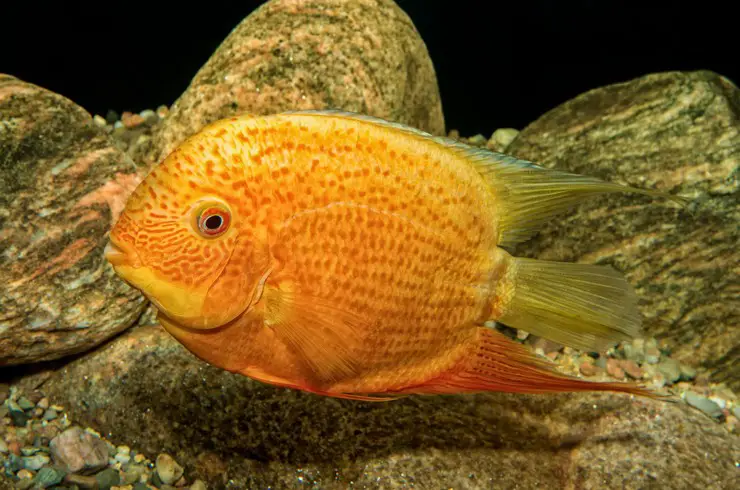
In nature, the scales of cichlazoma severum are colored greenish with a golden-yellow belly, but in artificially bred fish, the palette is much wider: green, blue, yellow, orange, and red, in various combinations and with different patterns. Brightness to these fish is given by multi-colored specks – pink, yellow, brown, or red. Juveniles also have their own coloring – paler than adults, but with eight contrasting dark stripes crossing the entire body from across. With age, the stripes gradually fade and shorten, giving way to an adult, spotted pattern.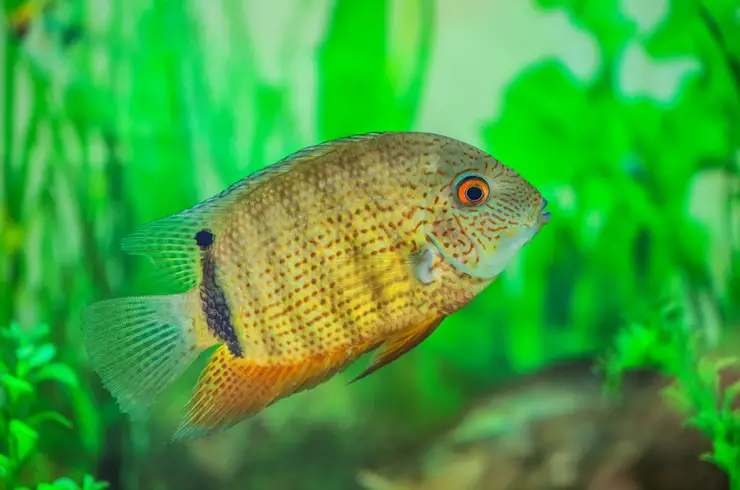
Habitat
These vibrant tropical fish are native to South America. Tsichlazoma severum was first discovered by Australian Johann Natterer during his expedition along the Amazon River between 1817 and 1835. However, only the Austrian zoologist and ichthyologist Johann Jakob Heckel described this species in detail in 1840. In his work, the scientist relied on materials collected by Natterer.
The habitat of these fish is quite wide and is not limited to one Amazon: you can meet them in freshwater bodies of Brazil, Guiana, Colombia, and Venezuela – including in the Orinoco and Rio Negro river basins.
The natural food base of the false discus is insects and fry, as well as algae, zooplankton, and detritus.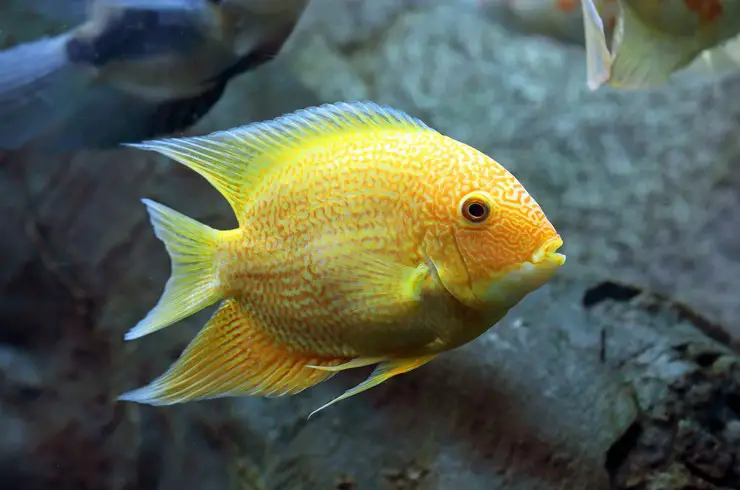
Care and maintenance
Cichlazoma severum is much more hardy than most of its congeners: it feels good in warm (20-28 ° C) water, with neutral acidity (the pH should be maintained within 6.8-8.0) and almost any hardness (GH range 6-20 °). Although the optimal temperature for it is + 25 ° C, it easily tolerates temperature fluctuations and, moreover, is resistant to diseases.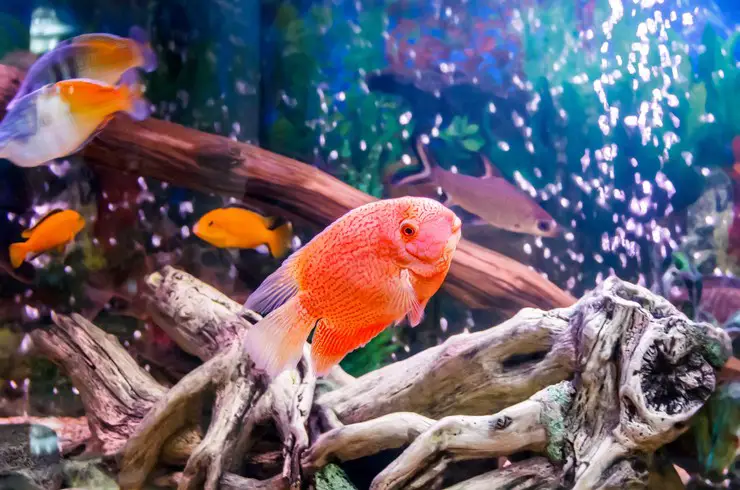
But remember that this species is quite large, as well as territorial, like all cichlids. Therefore, to maintain them, you need a spacious aquarium – at least 200 liters, and the more, the better. The container can be actively filled with decorations, they will help to zone the space and serve as a shelter for the neighbors of false discus who accidentally find themselves in foreign territory. Artificial rocks, stones, and grottoes are what you need when keeping cichlids.
But with plants you will have to be more careful – cichlazoma severum is not indifferent to greenery and usually quickly destroys it. Only hard-leaved species with a developed root system can withstand its pressure – and provided that the roots are protected by boulders. It is much easier to abandon vegetation altogether, limiting ourselves to stones and snags.
Another important condition for a comfortable home-keeping cichlazoma severum is clean water with a light flow. It is best to replace 1/5 of the water in the tank weekly, and the rest of the time to use good filters and maintain high-quality aeration of the artificial reservoir.
The fish does not like bright lighting and even prefers shaded areas. She is also very shy and can jump out of the water, so the aquarium will definitely need a cover.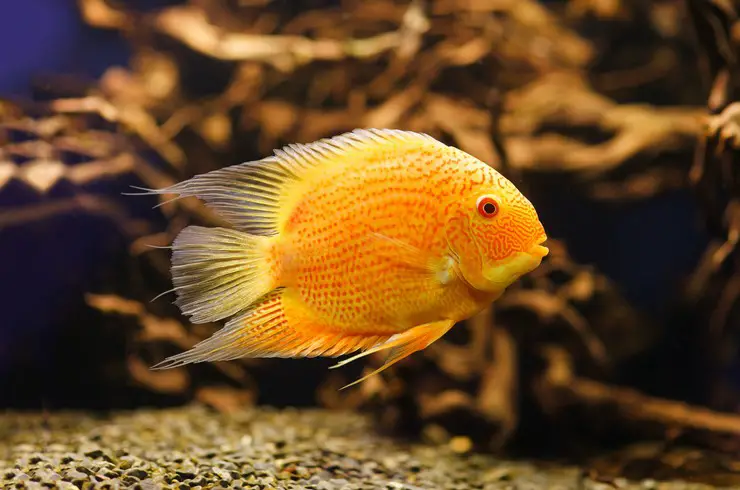
Compatibility
When adding a severum cichlazoma to an aquarium with other fish, it should be remembered that a disposition, which can be considered peaceful for cichlids, will pose a serious danger to slow and small species. These fish categorically do not get along with goldfish, Cecilia, tetras, and neons.
Cichlazoma severum will not be able to live safely and side by side with representatives of its own species – it perceives its relatives exclusively as competitors for the territory that it aggressively protects.
Other cichlids, similar in size and character, will become comfortable neighbors for representatives of this species – these are astronauts, meek, black-striped, and bees. They exist quite well with large catfish – provided that the severum cichlaz has its own territory.
Feeding the serums
Representatives of this species are omnivorous. In nature, they can eat both plant and animal food; when kept at home, they willingly eat dry food.
It is recommended to use foods such as Tetra Cichlid Color or Tetra Cichlid Pro – they are specially formulated with the needs of these fish in mind and will help them to maintain a bright color and excellent health.
The main rule that applies when choosing food for severum cichlazoma (however, as for most aquarium fish) is that it should be varied. Therefore, from time to time you can pamper your pets with healthy and nutritious treats from the Tetra FreshDelica series.

